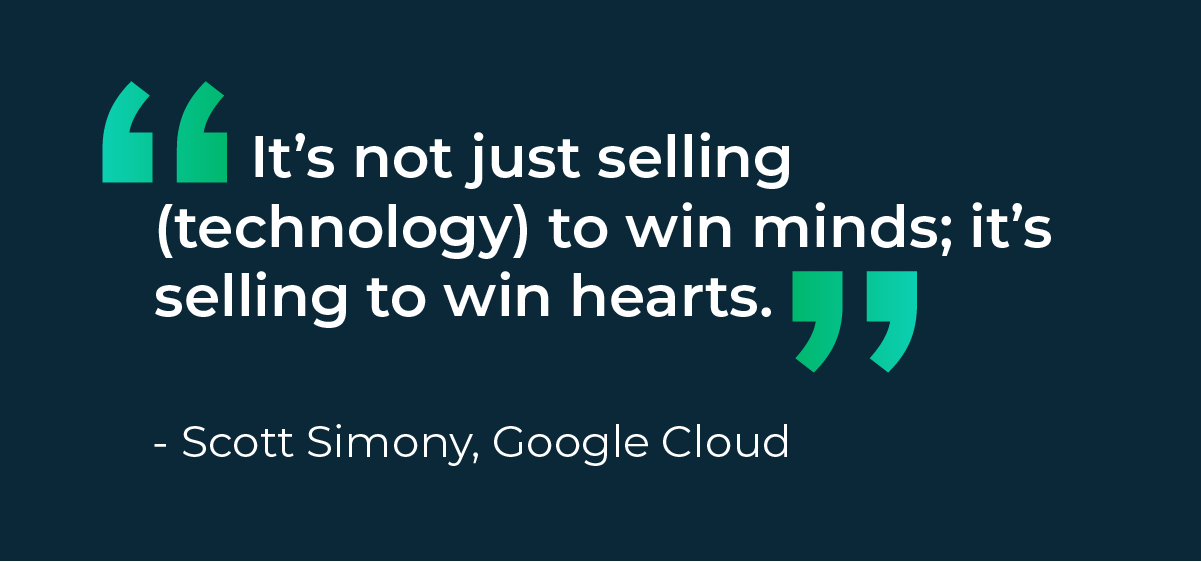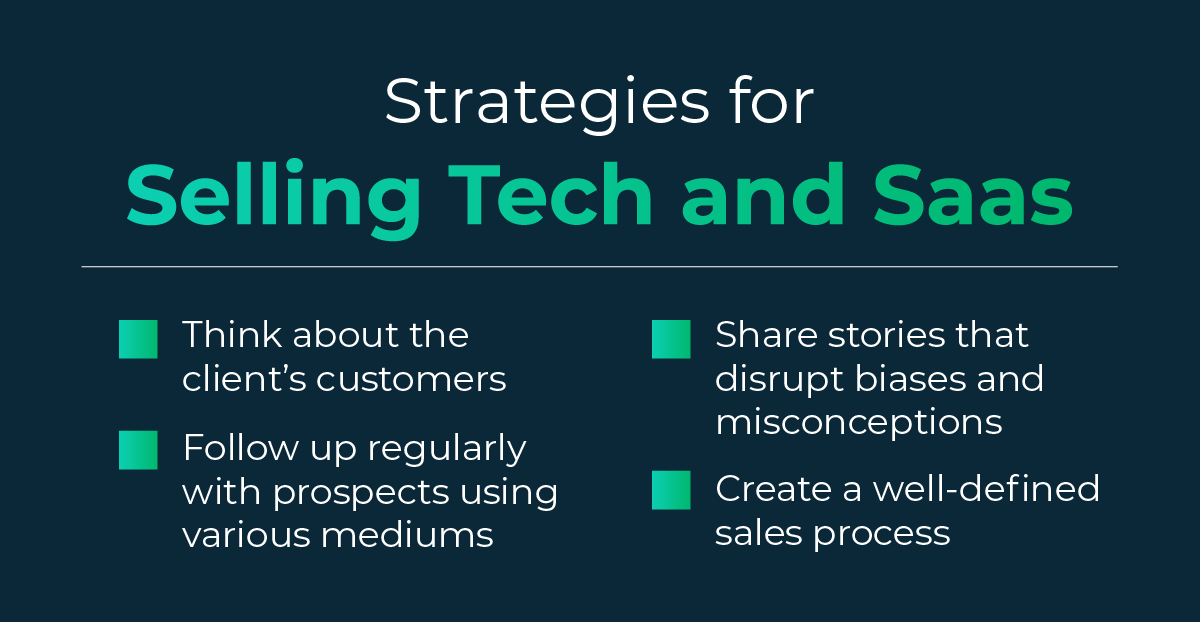Secrets to Technology and SaaS Sales: Strategies, Challenges, and More

B2B technology and SaaS products have been game-changers for businesses in virtually every industry—and demand continues to rise rapidly.
The COVID-19 pandemic has only added fuel to that fire. In 2020, McKinsey & Company found that companies had accelerated the digitization of their operations by three to four years and the share of digital or digitally-enabled products in their portfolios by seven years—and that was early in the pandemic.
Despite the widespread need for innovative solutions, a crowded marketplace and the complexity of tech products mean technology and SaaS products demand a unique sales approach. In a recent conversation with Emeritus Enterprise, Craig Wortmann, clinical professor of marketing at Northwestern University’s Kellogg School of Management and founder and academic director of the Kellogg Sales Institute, and Scott Simony, director of sales at Google Cloud, shared tried-and-true tips for success in this fast-evolving space.
The Challenges of Selling Technology and SaaS
Simony noted that selling technology products presents several unique challenges that demand a high level of creativity and critical thinking.
1. Change Management
“At the end of the day, what you’re selling is change,” Simony said at the Emeritus event. While technology and SaaS products exist to solve specific problems, they often do so by changing the way companies do business. This can be overwhelming to potential clients.
Successful tech salespeople understand the psychology of change management and use it to give clients ideas and guide their decision-making processes. “It’s not just selling to win minds; it’s selling to win hearts,” Simony said.
2. The Need for Horizontal Consensus
“Tech is pervasive in almost every company in every industry,” Simony said. “And I find that it’s not the sole responsibility of the CIO or CTO anymore. It’s a key responsibility across the C-suite and in many different functions of the organization.”
Salespeople shouldn’t focus only on building relationships and pitching products to traditional tech stakeholders. Instead, they need to identify colleagues across the organization who might contribute to product decisions. Then, they should learn about their needs and share how their product can address specific pain points.
3. Bringing Tech Products to Life
As Simony noted, “Technology can be an overused term that means everything and nothing.” The value of products in this space can feel abstract and hard to grasp. That means salespeople need to be able to bring ideas and solutions to life so that potential clients clearly understand how they work within practical, everyday business processes.
Mistakes to Avoid in Technology Sales
Between them, Simony and Wortmann have built sales organizations at some of the world’s largest tech companies. And they agreed that salespeople often fall into three common traps.
1. Overemphasizing Technological Expertise
Often, Simony explained, early-career tech salespeople tend to try to prove their competence by positioning themselves as technological experts. This can cause them to tell potential clients about a product rather than really listening and understanding their clients’ needs.
“If you care about the company you’re calling on, whether they make cardboard boxes, sell insurance, or run hospitals, you need to be curious about the business, ask questions, and be vulnerable enough to not know everything,” Simony said.
Wortmann agreed, sharing that early in his career, he fell for that pitfall. But he advanced significantly once he learned to stop and really listen to prospects’ concerns and needs.
2. “Selling Widgets”
While a traditional approach to technology sales might focus on year-over-year metrics or cost reduction, Simony said, emphasizing the specifics of a product (“selling widgets”) or baseline numbers alone don’t create a compelling case for purchase in today’s technology environment.
“Time is the most valuable resource,” Simony said. “And if you’re not spending time with those companies, solving some meaningful problems that will change the way they operate, then I think that we’re probably actually underselling the real change that technology can provide.” Executives aren’t just looking to technology sales for products, according to Simony–but also for a fresh perspective and new ideas that can shake up their business.
3. Short-Term Thinking
“Those who do best in sales are taking a long view,” Simony said. He explained that salespeople who build strong careers don’t focus on simply hitting their targets and getting as many sales as possible. Instead, they build relationships of trust with their clients.
When somebody selling technology becomes a true knowledge partner, that can open up opportunities to sell future products. In turn, you develop what Simony referred to as a “symbiotic relationship where growth is the name of the game on both sides.”
How Tech Sellers Can Help Companies Navigate Digital Transformation
As companies tackle the challenges of digital transformation, tech sellers can also serve as partners in envisioning what’s possible. Simony explained that while organizations have scrambled to react to the demands of the pandemic—for example, by implementing remote work policies or delivery programs—many have not yet fleshed out complete transformation strategies. This leaves open numerous opportunities for salespeople to add value.
However, Simony said moving the needle often depends more on understanding the company’s and customers’ needs than pushing a flashy new product. Simony used the Starbucks app as an example. He asked attendees to imagine the boardroom conversation underpinning that app or any other comparable innovation.
“I wonder if the conversation was around, how do we help people get coffee faster? How do we make sure that people want to come back to Starbucks more frequently and don’t go to the competitors? Those are the things I think that salespeople could take heed of and listen to.”
Simony urged salespeople to think about what problems prospects’ companies are trying to solve and then look for ways their technology can help. “Don’t be a hammer looking for a nail,” he advised.
Wortmann noted that stories about other companies (can provide a vital entry point for conversations with prospects. “You can use that one great story as a launchpad to be vulnerable and be curious with your listening.”
How Successful Sellers Position Their Products
In addition to those key strategic considerations, Simony and Wortmann offered tactical tips for closing the deal.
1. Think About the Client’s Customers
Just as salespeople keep their prospective clients front of mind, those clients base their own decisions on their customers’ needs. When salespeople understand those motivations, it’s easier to identify and share compelling narratives. These may focus on how the product can impact the potential client’s workflow and their customers’ experience.
2. Share Stories That Disrupt Biases
When selling emerging technology like artificial intelligence, many salespeople run into prospective clients’ biases and misconceptions around its uses and costs. Simony urged salespeople to resist the urge to lean on facts and statistics. Instead, he said, they should share real stories about how other companies have benefited from adopting technologies. Acknowledging the magnitude of the shift can go a long way toward reassuring reluctant adopters.
3. Follow Up Regularly
While many salespeople are rightly concerned about not becoming a pest, Simony and Wortmann emphasized the importance of regular follow-up with prospects.
“From writing hand-written thank-you notes to simply making a follow-up ‘check in’ phone call, good follow-up shows that you are striving to help your customers and prospects make progress for themselves and their businesses,” Wortmann explained.
Mixing communications mediums, like switching between emails and phone calls, is just one way for salespeople to demonstrate both creativity and sincerity.
4. Have a Defined Technology Sales Process
Wortmann said he is “sales process agnostic” and does not recommend one approach universally. However, he emphasized the importance of developing and sticking to a clearly-defined approach as a business.
“Knowing your sales process means understanding and agreeing to what must be true of a prospect to move that opportunity from one stage to another through the sales process,” Wortmann said. “This gives the salesperson more confidence that they know what to do and how to do it to continue moving prospects toward a decision.”
Learn More About Technology Sales With Emeritus
Looking for additional help building out a world-class technology or SaaS sales team? Watch the full recording of the digital event with Simony and Wortmann for more insights. You can also view a full slate of Emeritus’ online sales and marketing courses.

















